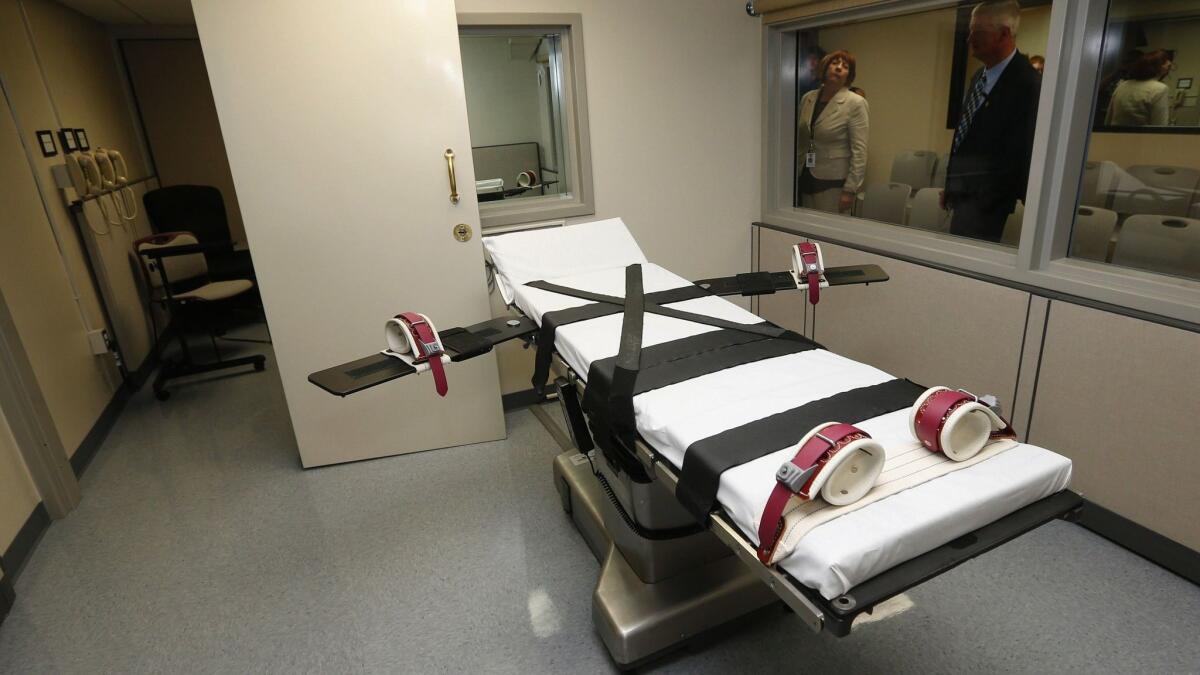Oklahoma is poised to become the first state to use nitrogen gas in executions

- Share via
Oklahoma plans to start carrying out executions with nitrogen gas, a method that has never been used in the U.S. but that some states have already approved amid difficulties with lethal injections.
At a news conference Wednesday, Oklahoma Atty. Gen. Mike Hunter and Corrections Director Joe M. Allbaugh said that over the next few months the state would develop a protocol for using nitrogen.
They did not give a date for finalizing the protocol or for the first execution. There are 49 inmates on death row in Oklahoma, including 16 who have exhausted the appeals process, Hunter said.
The last U.S. execution in a gas chamber was on March 4, 1999, in Arizona using cyanide. German national Walter LaGrand was put to death for taking part in the 1982 murder of a bank manager.
In recent years, Oklahoma and other states have struggled to obtain the drugs needed for lethal injections, the most common execution method but one that has increasingly faced scrutiny.
In 2015, a state court put a moratorium on executions in Oklahoma after a series of botched executions, including one in which an inmate convulsed for 43 minutes before dying and another in which the wrong drug was administered.
As inmates and groups opposed to the death penalty have gone to court to challenge lethal injection on the grounds that it amounts to cruel and unusual punishment, manufacturers of some of the drugs have refused to do business with states.
In one prominent case, McKesson Corp., a medical supplier that sold the muscle relaxer vecuronium bromide to Arkansas, said last year that the state had bought the drug under false pretenses. The company said the drug was intended for medical use only.
In 2015, Oklahoma legislators made a contingency plan in case lethal injection was found to be unconstitutional or the drugs became unavailable. They passed a law allowing the state to execute people by nitrogen hypoxia, in which a person is deprived of oxygen as nitrogen is inhaled.
“We can no longer sit on the sidelines and wait on the drugs,” Hunter said Wednesday. “Using inert gas will be effective, simple to administer, easy to obtain and requires no complex medical procedures.”
Dale Baich, an attorney representing 20 death row prisoners who have sued the state over its execution procedures, criticized the state’s announcement.
“This method has never been used before and is experimental,” he said in a statement. “Oklahoma is once again asking us to trust it as officials ‘learn-on-the-job,’ through a new execution procedure and method. How can we trust Oklahoma to get this right when the state’s recent history reveals a culture of carelessness and mistakes in executions?”
Concerns about executions have helped drive the number to historic lows in recent years and sent several states looking for alternatives to lethal injection.
Mississippi legalized using nitrogen gas last year but hasn’t yet used it. In Alabama, state legislators have also voted in support of using nitrogen gas. In Nevada and Nebraska, there have been pushes to use fentanyl in executions. In Utah, the firing squad has been legal since 2015.
Robert Dunham, the executive director of the Death Penalty Information Center, said Oklahoma’s role in the history of the death penalty could inspire more use of nitrogen gas. The state was the first to pass a law allowing lethal injection in 1977. Texas and dozens of other states followed.
“I expect that if Oklahoma goes forward with this, there will be more states,” said Dunham, whose nonprofit is based in Washington, D.C., and is critical of the death penalty.
Dunham said the state would also need to make a case in court that it could no longer obtain lethal injection drugs before turning to nitrogen gas.
“If the attorney general doesn’t do that, I expect the death row prisoners would seek a judicial review to determine if lethal injection is not available,” he said.
Even if Oklahoma prevailed, Dunham said, it would take at least six months for the first execution because of current court restrictions on the death penalty.
Jaweed Kaleem is The Times’ national race and justice correspondent. Follow him on Twitter, Facebook and Instagram.
More to Read
Sign up for Essential California
The most important California stories and recommendations in your inbox every morning.
You may occasionally receive promotional content from the Los Angeles Times.











